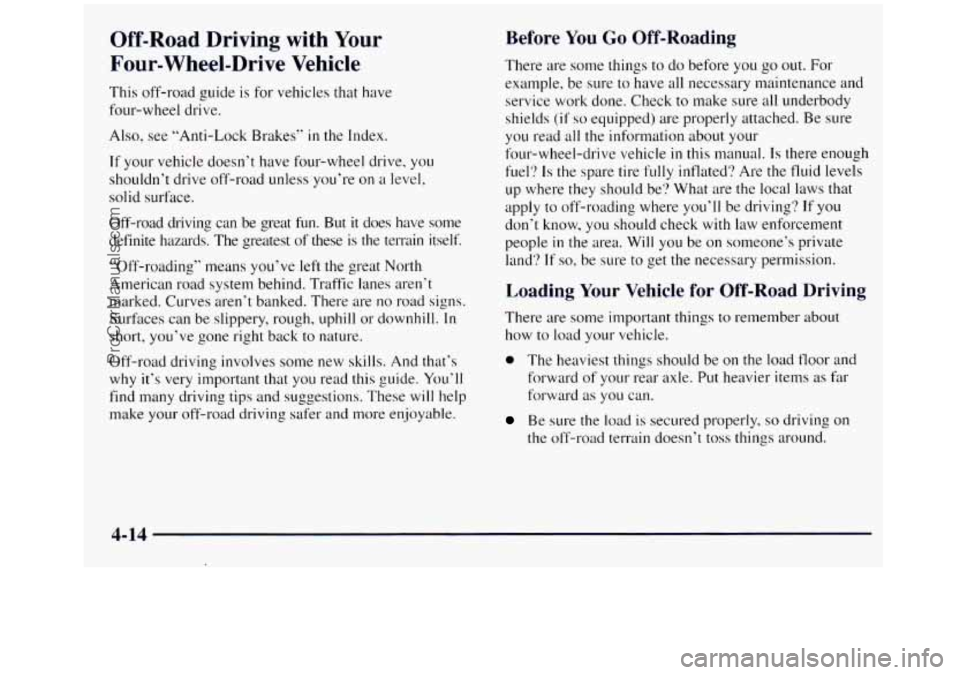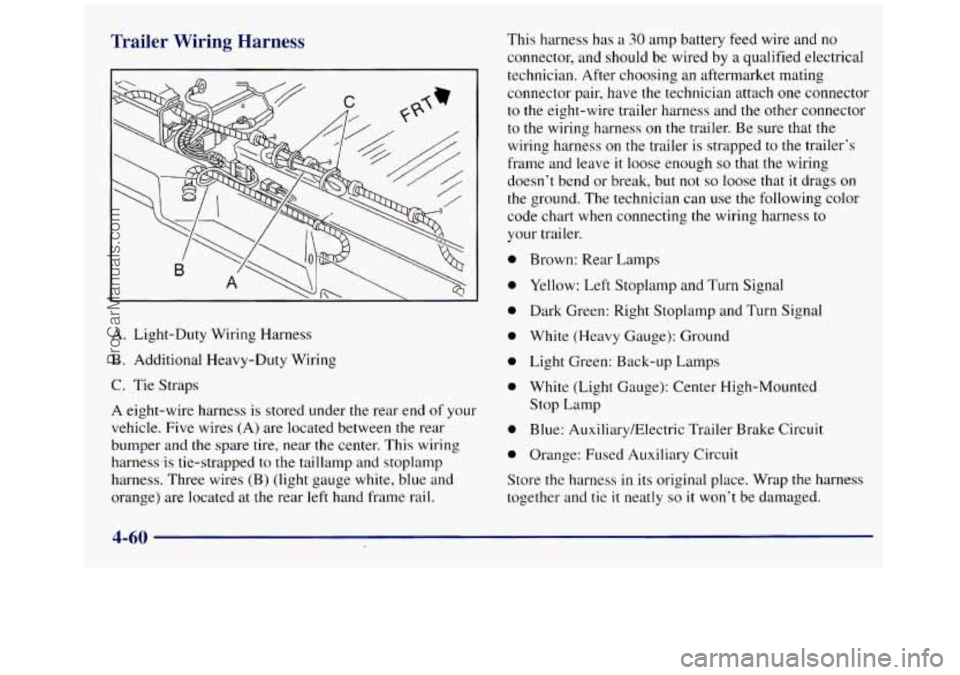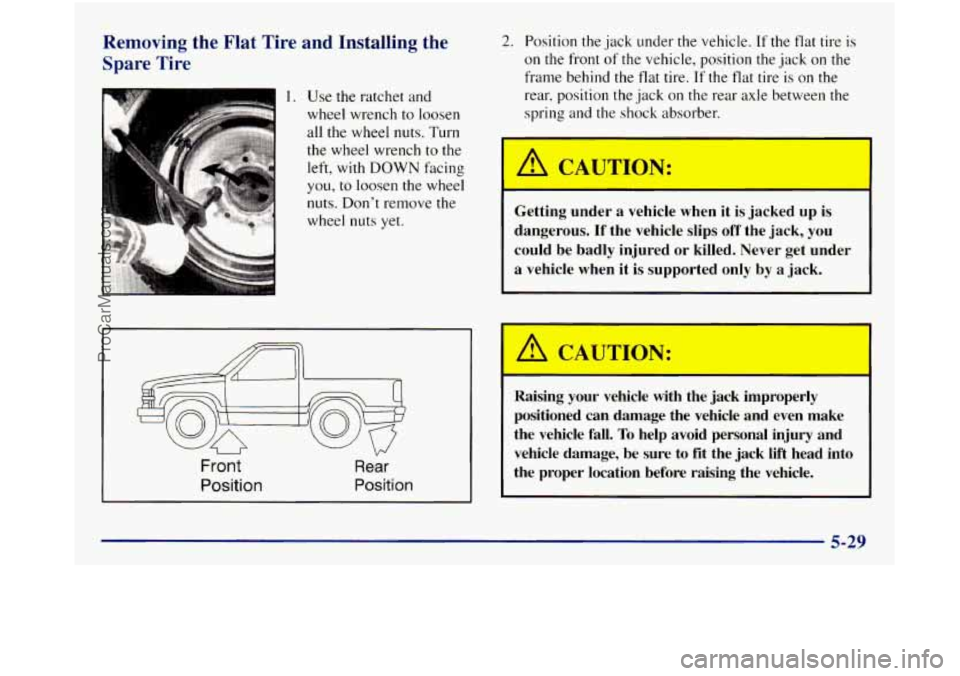Page 202 of 452

Off-Road Driving with Your
Four-Wheel-Drive
Vehicle
This off-road guide is for vehicles that have
four-wheel drive.
Also, see “Anti-Lock Brakes“
in the Index.
If your vehicle doesn’t have four-wheel drive, you
shouldn’t drive off-road unless you’re on a level,
solid surface.
Off-road driving can be great fun. But
it does have some
definite hazards. The greatest of these is the terrain itself.
“Off-roading” means you’ve left
the great North
American road system behind. Traffic lanes aren’t
marked. Curves aren’t banked. There are
no road signs.
Surfaces can be slippery, rough, uphill or downhill.
In
short, you’ve gone right back to nature.
Off-road driving involves some new skills. And that’s
why it’s very important that you read this guide. You’ll
find many driving tips and suggestions. These
will help
make your off-road driving safer and more enjoyable.
Before You Go Off-Roading
There are some things to do before you go out. For
example, be
sure to have all necessary maintenance and
service work done. Check
to make sure all underbody
shields
(if so equipped) are properly attached. Be sure
you read
all the information about your
four-wheel-drive vehicle
in this manual. Is there enough
firel‘?
Is the spare tire fully inflated? Are the fluid levels
up where
they should be‘? What are the local laws that
apply to off-roading where you’ll be driving?
If you
don’t know, you should check
with law enforcement
people
in the area. Will you be on someone’s private
land?
If so, be sure to get the necessary permission.
Loading Your Vehicle for Off-Road Driving
There are some important things to remember about
how to load your vehicle.
0 The heaviest things should be on the load floor and
forward of your rear axle. Put heavier items
as far
forward
as you can.
Be sure the load is secured properly, so driving on
the off-road terrain doesn’t toss things around.
4-14
ProCarManuals.com
Page 248 of 452

Trailer Wiring Harness
A. Light-Duty Wiring Harness
B. Additional Heavy-Duty Wiring
C. Tie Straps
A eight-wire harness is stored under the rear end of your
vehicle. Five wires (A) are located between the rear
bumper and the spare tire, near the center. This wiring
harnewis tie-strapped to the taillamp and stoplamp
harness. Three wires (B) (light gauge white, blue and
orange) are located at
the rear left hand frame rail. This
harness has a
30 amp battery feed wire and no
connector, and should be wired
by a qualified electrical
technician. After choosing an aftermarket mating
connector pair, have the technician attach one connector
to the eight-wire trailer harness and the other connector
to the wiring harness on the trailer. Be sure that the
wiring harness on the trailer is strapped to the trailer’s
frame and leave
it loose enough so that the wiring
doesn’t bend or break, but not
so loose that it drags on
the ground. The technician can use the following color
code chart when connecting the wiring harness to
your trailer.
0 Brown: Rear Lamps
0 Yellow: Left Stoplamp and Turn Signal
0 Dark Green: Right Stoplamp and Turn Signal
0 White (Heavy Gauge): Ground
0 Light Green: Back-up Lamps
0 White (Light Gauge): Center High-Mounted
Stop Lamp
0 Blue: Auxiliary/Electric Trailer Brake Circuit
0 Orange: Fused Auxiliary Circuit
Store the harness
in its original place. Wrap the harness
together and tie
it neatly so it won’t be damaged.
4-60
ProCarManuals.com
Page 277 of 452
Removing the SDare Tire. and Tools
2 and 4-DOOr Models Extended
Cab Models
The
equipment you’ll need is behind the passenger’s
‘seat. Turn the wing nut to the left and remove the jack
cover, if there is one. Remove the jacking equipment.
If you have a chassis cab, refer to the information from
the body supplierhnstaller for the location of your
spare tire.
You’ll use the jack handle and the ratchet to remove the
underbody-mounted spare tire.
5-25
ProCarManuals.com
Page 278 of 452
A. Hoist Assembly
€3. Ratchet
C. Jack Handle
D. Hoist Shaft
E. Valve Stem,
Pointed Down
E Spare Tire
G. Retainer
H. Hoist Cable Follow
these instructions to lower the spare tire:
1.
2.
3.
4.
One side of the ratchet has an UP marking. The other
side has
a DOWN marking. Assemble the ratchet to
the hook near the end
of the jack handle (as
illustrated) with the DOWN marking facing you.
Insert the other end through the hole in the rear
bumper and into the hoist shaft.
Turn the ratchet to lower the spare tire to the ground.
Continue to turn the ratchet until the spare tire can be
pulled out from under the vehicle.
When the tire has been lowered, tilt the retainer at
the end
of the cable so it can be pulled up through
the wheel opening.
Put the spare tire near the flat tire.
5-26 I
h
ProCarManuals.com
Page 281 of 452

Removing the Flat Tire and Installing the
Spare Tire
1. Use the ratchet and
wheel wrench to loosen
all the wheel nuts. Turn
the wheel wrench to the
left, with
DOWN facing
you,
to loosen the wheel
nuts. Don't remove the
wheel nuts yet.
Front Rear
Position Position
2. Position the jack under the vehicle. If the flat tire is
on the front of the vehicle, position the jack on the
frame behind the flat tire.
If the flat tire is on the
rear, position the jack on the rear axle between the
spring and
the shock absorber.
Getting under a vehicle when it is jacked up
is
dangerous. If the vehicle slips off the jack, you
could be badly injured or killed. Never get under
a vehicle when it is supported only by a jack.
/i CAUTIOL.
-
Raising your vehicle with the jack improperly
positioned can damage the vehicle and even make
the vehicle fall.
To help avoid personal injury and
vehicle damage, be sure to fit the .jack lift head into
the proper location before raising the vehicle.
5 - :
ProCarManuals.com
Page 282 of 452
Front Position Rear Position
3. With UP on the ratchet fixing you, raise the vehicle
by rotating the ratchet and wheel wrench to the right.
Raise the vehicle far enough off the ground
so there
is enough room for the spare tire to fit.
4. Remove all the wheel
nuts and take
off the
flat tire.
- --__.
I I
5. Remove any rust or dirt
from the wheel bolts,
mounting surfxes and
spare
w hee I.
5-30
ProCarManuals.com
Page 285 of 452
NOTICE:
Improperly tightened wheel nuts can lead to
brake pulsation and rotor damage.
To avoid
expensive brake repairs, evenly tighten the wheel
nuts in the proper sequence and to the proper
torque specification.
9. Put the wheel trim back on. For vehicles with plastic
wheel
nut caps, tighten the caps until they are
finger-tight, then tighten them an additional one-half
of a turn with the ratchet and wheel wrench.
Storing a Flat or Spare Tire and Tools
A CAUTION:
Storing a jack, a tire or other equipment in the
passenger compartment
of the vehicle could
cause injury. In
a sudden stop or collision, loose
equipment could strike someone. Store
all these
in the proper place.
Store the flat tire where the spare tire was stored.
5-33
ProCarManuals.com
Page 286 of 452

For an underbody spare tire carrier, store the tire under
the rear
of the vehicle in the spare tire carrier. To store
the tire:
1.
2.
3.
4.
5.
Put the tire on the ground at the rear of the vehicle
with the valve stem pointed down and to the rear.
Tilt the retainer downward and through the wheel
opening. Make sure that the retainer
is fully seated
across the underside
of the wheel.
Attach the ratchet, with the
UP mark facing you,
near the hook at the end
of the jack handle. Insert the
other end, on an angle, through
the hole in the rear
bumper and into the hoist shaft.
Raise the tire fully against
the underside of the
vehicle. Continue turning
the ratchet until there. are
two “clicks” or “ratchets.” The spare tire hoist
cannot be over-tightened.
Grasp and push against the tire to be sure
it is stored
securely and does not move.
I Lower Raise
A. Hoist Assembly
B. Ratchet
C. Jack Handle
D. Hoist Shaft
E. Valve Stern,
Pointed Down
E Flat or Spare Tire
G. Retainer
H. Hoist Cable
Return the jack, ratchet, wheel wrench
and jack extensions
to their location behind the passenger’s seat. Secure the
items and replace the jack cover,
if there is one.
5-34
ProCarManuals.com